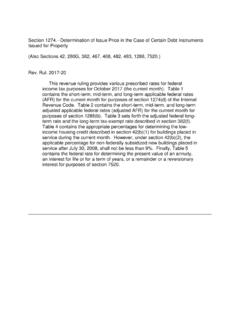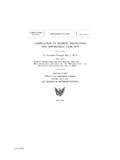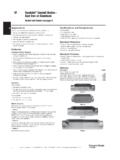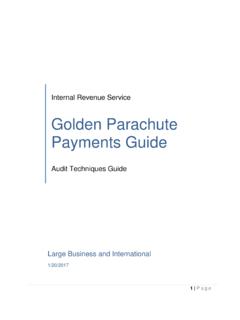Transcription of Correcting Operational and Document Failures to …
1 Correcting Operational and Document Failures to Comply with IRC section 409A by Dodd S. Griffith, Esq., Gallagher, Callahan & Gartrell, PC and Kenneth C. Wolfe, CPA, Nathan Wechsler & Co., PA November, 2012 Contents Correcting Operational and Document Failures to Comply with IRC section 3 Overview .. 3 What is the Basic Purpose of section 409A? .. 4 In a Nutshell, How does section 409A Work? .. 5 What Compensation is Covered by section 409A? .. 9 What Compensation is Exempt from section 409A? .. 10 Who is Impacted by a failure to comply with section 409A? .. 13 What Current IRS Audit Initiatives Focus on Compliance with section 409A? .. 14 What Correction Programs are Available for Noncompliance with 409A? .. 19 Correction Programs for Operational Failures .. 19 Overview .. 19 What are Operational Failures ? .. 20 Which Operational Failures can be Corrected Using the Corrective Procedure? .. 21 Who is Eligible to Use the Corrective Procedure?
2 22 What are the Deadlines for Correcting Operational Failures ? .. 24 Examples of How to Correct Common Operational Failures .. 30 Correction Programs for Document Failures .. 35 Overview .. 35 Who is Eligible to Use the Corrective Procedure? .. 35 What are the Deadlines for Correcting Document Failures ? .. 37 Transitional Relief ending on December 31, 2012 for Errors related to Conditioning Payment of Deferred Compensation on Giving Release, Non-Compete, or the Like .. 45 What is the Release Timing Problem? .. 46 How does the New Corrective Procedure Work? .. 46 How Do I Amend a Non-Compliant Plan to Qualify for Relief? .. 47 3 Correcting Operational and Document Failures to Comply with IRC section 409A Overview A surprising range of agreements include an element of deferred compensation that is subject to Internal Revenue Code section 409A ( section 409A ) and its implementing Treasury Regulations, section , et seq.
3 (the 409A Rules ). The penalties for failure to comply are quite harsh. The IRS is stepping up its audit activity in this area, and has recently provided guidance on self-correction procedures. The IRS guidance covers Operational Failures and Document Failures , and often provides the best relief if corrections are made during the plan year in which the failure occurs. This segment will review the section 409A self-correction program guidance offered by the IRS; as well as current audit guidelines. This segment will also provide a brief review of the types of deferred compensation that are subject to compliance with section 409A; applicable exemptions; and a review of common errors. NOTE The following summary of section 409A and the 409A Rules is provided for the sole purpose of helping you spot potential problems with deferred compensation arrangements that are required to comply with the requirements of section 409A.
4 Since the focus of this program is how to use the available IRS correction programs to correct such problems once you identify them, these program materials provide what is, by design, a very simplified overview of a very complex set of rules. The summary is not intended as a guide on how to properly draft or administer a deferred compensation arrangement that complies with, or is exempt from compliance with, section 409A. You should not use it for that purpose. 4 What is the Basic Purpose of section 409A? The purpose of section 409A is to deny the recipient of deferred compensation any and all discretionary rights to control the time at which deferred compensation is ultimately paid, or the form in which it is paid. In order to understand the intentional rigidity of section 409A and the 409A Rules, and the stringent manner in which the IRS enforces the 409A Rules, it is important to understand the history of deferred compensation prior to the enactment of section 409A.
5 The common law that had developed prior to the enactment of section 409A was not particularly favorable to the IRS. Taxpayers were, in many cases, permitted to defer recognition of taxable income, while retaining a fairly significant amount of control over how and when that income was actually paid. For example, prior to the enactment of section 409A, it was common for deferred compensation plans to give the recipient of the deferred compensation the right to elect whether to receive the compensation in a lump sum, or in a series of periodic payments. It was also a fairly common for deferred compensation plans to include a haircut provision which allowed the recipient to accelerate the date of payment in consideration for taking a reduced payment (the theory being that the haircut constituted a substantial risk of forfeiture that justified the deferred income recognition, notwithstanding the discretionary right to accelerate the date of payment).
6 The IRS took the position that, if the taxpayer retained any discretionary rights to elect a form of payment, or to change the time of payment, then there was no actual deferral of income and, hence, no deferral of income recognition. However, due to unfavorable common law, the IRS had been unable to successfully enforce its position. With the enactment of section 409A, the IRS finally gained the tools it needed to implement its desired policy position. Although the 409A Rules exceed 400 pages in length, and 5 are quite complex, the basic philosophy behind these rules is fairly simple. The 409A Rules are designed to make it virtually impossible for a recipient of deferred compensation after the date of award to change the time at which that deferred compensation is paid, or the form in which it is paid, without triggering the inclusion of that deferred compensation in current income (and incurring significant additional tax penalties).
7 The 409A Rules also seem to assume that employers and employees are actively looking for ways to manipulate a broad range of compensation practices with an eye towards allowing employees to earn the right to income in one year, and defer the recognition of tax on that income into future years. Once you understand the mindset of the IRS drafters, it makes it easier for you to spot potential problems that you may be able to correct using one of the IRS correction programs. In a Nutshell, How does section 409A Work? If compensation is deferred compensation for purposes of section 409A, then: The compensation may not be paid to the service provider until a permissible payment event occurs. See Treas. Reg. (a). The only permissible payment events are: o A fixed date or series of fixed dates (for example a single lump sum payment on January 1, 2013, or a series of 10 annual payments of $10,000 each, commencing on January 1, 2013 and continuing on January 1 of each of the subsequent 9 years).
8 O A separation from service (Caution you may think that separation from service = termination. That is not necessarily the case. The definition of what constitutes a bona fide separation from service is complex and under certain circumstances, 6 it may be that no separation from service has occurred, even when an employee has been terminated (for example, when the former employee is retained as a consultant). o Death (Amazingly, the IRS chose not to promulgate regulations defining death but if you are fan of tax-related humor, you can find some fake section 409A regulations defining death that are circulating on the internet). o Disability (Caution the 409A Rules have a very specific definition of what constitutes disability and it is much more restrictive than the typical disability insurance policy). o A change in control transaction (There is a complex definition that largely follows the rules promulgated under IRC section 280G with respect to the taxation of excess parachute payments).)
9 O Unforeseeable emergency (Caution the definition of unforeseeable emergency is fairly restrictive and is generally limited to bona fide medical emergencies or similar events that could not be foreseen deciding you need money to pay for a child s college education does not count.) Generally, a plan may designate only one time and form of payment for each permissible payment event. See Treas. Reg. (c). However, there are some exceptions to this rule. For example, alternate payment schedules are permitted if (i) death, disability or a change in control occurs before or after a single specified date ( before or after attainment of a specified age or specified number of years of service), (ii) a separation from service occurs before or after a single specified date, or (iii) a separation from 7 service occurs within a limited period following a change in control that cannot exceed 2 years. If the service provider is given the right to designate the time and form of payment ( the applicable payment trigger, and whether the payment is lump sum or a series of periodic payments), then the service provider must generally make an irrevocable election by the last day of the tax year before the year in which the service provider performs the services to which the compensation relates.
10 See Treas. Reg. (a). In certain cases, the service provider will also be permitted to make an irrevocable election not later than the 30th day after becoming eligible to participate in deferred compensation plan. Generally speaking, the time and form of payment may not be changed at a later date. See Treas. Reg. (b). Regardless of whether or not the service provider is given the right to designate the time and form of payment, the agreement providing the deferred compensation must provide: o a specific, fixed payment date (for example, either the date the permissible payment event occurs, or a payment date following the occurrence of the permissible payment event, that is objectively determinable and non-discretionary (for example payment will be made on the first day of the second month following the service provider s death); and o a specific, fixed form of payment (for example, a lump sum payment, or a series of periodic payments in amounts and at dates that are specified at the time the compensation is initially deferred).)







